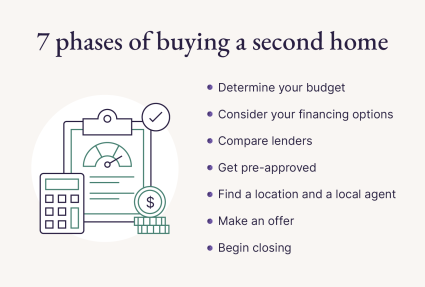Menu
1. Determine your budget

Second home expenses
In addition to the purchase price, be sure to factor in these expenses when budgeting for a second home:- Interest: On top of your mortgage payment, expect the interest rates for your second home loan to be higher than the going rate for a primary home.
- Property taxes: How much you pay in property taxes will depend on your location. The bank usually estimates your property taxes in your monthly mortgage payment.
- Homeowners insurance: The insurance for your second home is usually more than for your primary home, and it will vary depending on if it’s a rental or rarely occupied.
- HOA fees: If your second home has a homeowners association, you must account for the added monthly expense. HOA fees vary widely, depending on the amenities offered.
- Utilities: Whether you’re using the second home or planning to use it as a short-term rental, you’ll need to budget for monthly expenses. If you plan to have long-term tenants, you might have them pay the utility bills.
- Maintenance: Prepare to pay for lawn care, snow shoveling and any repairs tied to home ownership. Broken washers and dryers and roof repairs may be rare, but they can throw your budget into turmoil if you don’t set aside funds.
- Property management expenses: If you live far from your second home, handling property management yourself might not be feasible. In that case, you’ll need to hire a property manager to coordinate regular maintenance and handle tenant issues.
Potential second home tax deductions
As you’re crunching the numbers, remember your second home can also be a source of rental income and tax breaks. Depending on how your second home is classified and used, you may be able to:- Deduct mortgage interest payments on principal amounts up to $750,000.
- Earn short-term or long-term rental income, depending on local regulations.
- Deduct rental-related expenses, including repair costs and depreciation.
2. Consider your financing options
Lenders often see second homes as being higher risk for loan repayment. For this reason, second home loans have a few key differences from first mortgages. Some financial notes regarding buying a second home:- You need to pay a larger down payment. If you don’t have at least 10% of the second home’s cost on hand, you may struggle to find a lender. If that takes all of your savings, you’ll be at a disadvantage to deal with unexpected expenses like home repairs.
- There are higher credit score requirements. According to The Mortgage Reports, the lowest credit score to qualify for a conventional home loan is 620.
- Be mindful of your debt-to-income (DTI) ratio. Your DTI ratio includes all of your current debts plus the added debt of the second home. So make sure your DTI doesn’t exceed the 43% limit most lenders have for applicants.
- Prepare for higher interest rates. Adding an extra 0.5% to a normal mortgage may seem small, but it adds up over a 30-year period.
Becoming a co-owner
Buying a second home doesn’t have to be a solo endeavor. Joint ownership can increase your buying power and reduce a second home's maintenance and management burden. You can choose to invite one or more friends or family members to share ownership with you and use a lawyer to draw up an agreement.| Second home buyer tip: If you choose a co-ownership LLC through Pacaso, you can apply for second home financing offered by one of our banking partners. Pacaso serves as a corporate guarantor of the loan, vetting qualified buyers and protecting you if a co-owner defaults. |
3. Compare lenders
When comparing lenders for a second home, it's essential to conduct a thorough evaluation to secure the best financing option tailored to your specific needs. Consider the following factors and use them as a basis for comparison:- Loan terms: Examine the loan terms, including the duration of the loan and any associated fees. Longer loan terms may result in lower monthly payments but can lead to higher overall interest costs.
- Loan-to-value ratio: Assess the loan-to-value (LTV) ratio, which is the loan amount compared to the appraised value of the property. A lower LTV ratio may result in better loan terms.
- Closing costs: Compare the closing costs associated with each lender. These costs can vary, and understanding them helps avoid unexpected financial burdens at closing.
- Prepayment penalties: Check for prepayment penalties, as some lenders impose fees for paying off the loan early. Opting for a lender without such penalties provides flexibility if you decide to refinance or pay off the loan ahead of schedule.
| Second home buyer tip: Don’t get pressured to go with a certain lender on the spot. Make sure you’ve evaluated different options and give yourself time to consider the pros and cons of each one. |
4. Get pre-approved
Getting pre-approved for a second home is a simple process, with many lenders allowing you to apply online. They look at your financial history, including your current income and debts, to give a rough number regarding what you can afford. At this stage, consult multiple lenders to find the best interest rates available. Having a pre-approval letter from a lender can give you a leg up when it’s time to make an offer on your dream second home. Be aware, however, that since some lenders may see financing a second home as a higher risk, the loan they approve you for may be lower than what you’re expecting.5. Find a location and a local agent

- How often will you be there? If your second home will be a frequent weekend getaway, you’ll want something within driving distance of your primary residence. If you plan to use it for longer stays a few times a year, then something farther away could work well.
- Can I afford to live far away? The farther away your second home is, the more challenging it will be to manage, so you might need to rely on a property manager. Distant locations will also require higher travel costs, and locations prone to natural disasters — like beachfront property vulnerable to hurricanes — will cost more to insure.
- Do I want a home in a high-traffic area? Places with warm winter weather like Palm Springs or year-round adventures like Lake Tahoe are likely to stay rented and sell more quickly than one in a more remote location. However, they also cost more.
Choosing the right agent
Finding a knowledgeable agent in your target market can significantly decrease your workload in your second home search. You can use their local knowledge to help you with logistics and make an informed decision. Research local agents online, cross-reference reviews and ask for recommendations from your friends and family when possible. According to Redfin, the going rate of a real estate agent is about 5% of the home’s sale price. Commissions are negotiable, so if you find a real estate agent with a higher-than-average rate, you may be able to talk them down.6. Make an offer
Purchasing a second house will be a familiar process if you’re already a homeowner: You make an offer, negotiate, come to an agreement and prepare for closing. Prior to closing, you will:- Have a professional home inspector walk through the house. They’ll look for any issues that weren’t previously disclosed so you can make an informed decision regarding your purchase. You can negotiate with the seller or walk away if the inspection reveals anything major.
- Have a professional home appraisal conducted. Your lender will arrange for an appraisal, which determines the home's real value to compare it to the listing price. You can proceed with the sale if the appraisal is equal to or higher than the listing. If the appraisal comes in lower, you should try negotiating for a price closer to the appraised value.
- Purchase homeowners insurance. You’ll need proof of insurance before you can close on the second house. Compare rates from different insurance providers to find the best rate. Remember to account for local risks, like flooding or fires, that may need to be added on to your coverage.
- Conduct a final walkthrough. Even though you’ve (likely) already toured the home, you’ll want to ensure it’s move-in ready. The final walkthrough is your fail-safe for avoiding buyer’s remorse.
7. Begin closing
After the seller accepts your offer, the second home closing process begins. This process involves several crucial steps:- Select a real estate attorney or closing agent: Depending on the state in which you are closing, the services of a real estate attorney may be necessary to handle settlement and closing paperwork.
- Bring proof of homeowners insurance: Secure homeowners insurance and provide proof at closing for your lender to release funds.
- Acquire title insurance: Your lender will collaborate with a title company to investigate any existing issues with the property for a clear buying process. The title company will also issue title insurance to protect your new home purchase.
- Schedule another home inspection: Conduct a comprehensive home inspection to thoroughly examine the property one more time. Work with your agent to negotiate with the seller on pricing or repairs if issues arise.
- Await appraisal results: Although you can conduct the appraisal before the inspection, the latter helps identify major issues early on. Your lender can arrange for a home appraisal to verify the accuracy of your home's value.
- Arrange a final walk-through: Schedule a final walk-through to ensure the home is in optimal condition for the purchase.
- Close on your second home: Cover any remaining closing costs, sign all necessary paperwork and receive your keys!

How to buy a second home FAQ
01: What do I need to buy a second home?
To buy a second home, you’ll need to secure financing (unless you plan on paying in cash) and a real estate agent to help you navigate the home buying process. Alternatively, you can buy a second home through Pacaso and take advantage of our financing partners.
02: What is considered a second home for tax purposes?
For tax purposes, a second home is a property you own but don't use as your primary residence and typically functions as a vacation home.
03: How can I buy a second home online?
To buy a second home online, research real estate listings on reputable house buying websites. Use virtual tours and video calls to assess potential homes. You can also work with a local real estate agent who can facilitate the second home buying process remotely.
04: Can I buy a second home without a mortgage loan?
Yes, you can purchase a second home in cash without a mortgage loan. You can also use a home equity loan or a home equity line of credit (HELOC) to purchase a second home.
05: Is now a good time to buy a second home?
The right time to buy a second home depends on your financial situation and ability to finance and manage the responsibilities of owning a second home.
06: What’s the difference between a second home vs. an investment property?
A second home is for your personal enjoyment. As a vacation home, you must occupy it for a portion of the year. An investment property, however, is purely for financial gain. You buy it to rent out or for its value to increase, with minimal personal use. Lenders and tax rules treat them very differently.
07: Can I use a FHA loan to finance a second home?
No, generally not. FHA loans are designed to help people buy their primary residence. The FHA's mission is to support homeownership for those who will live in the property as their main home. This doesn't apply if the property—as a second home—is not your primary residence.









